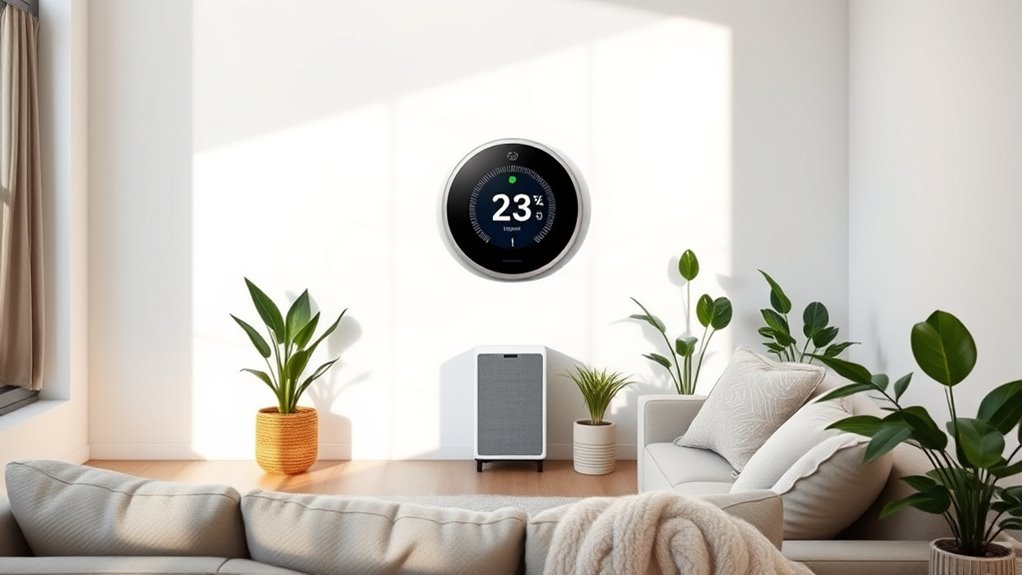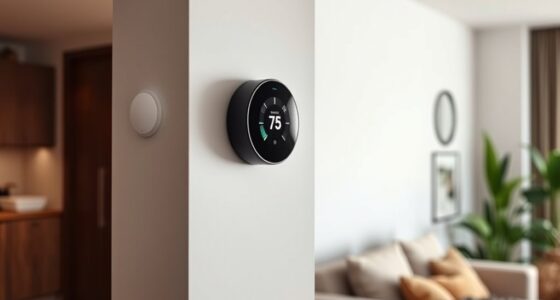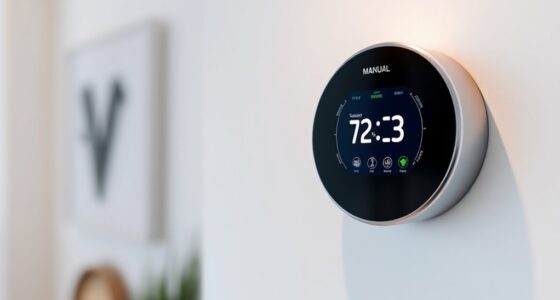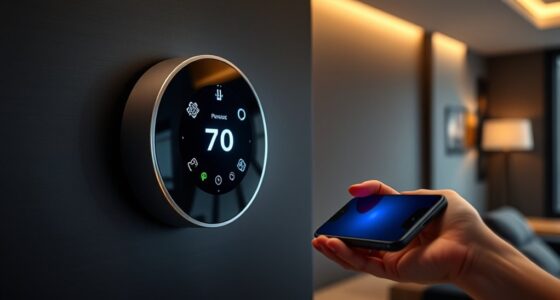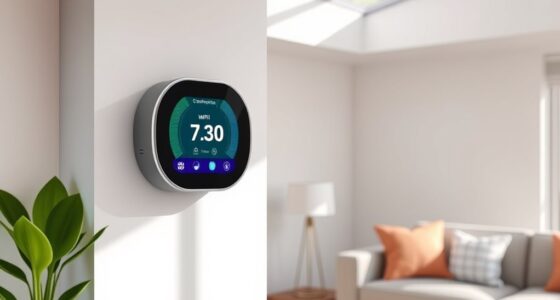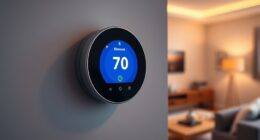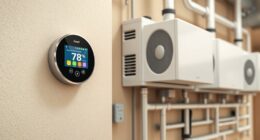If you’re looking for the best smart thermostats to help allergy sufferers, I recommend models that support advanced air quality features, humidity control, and easy integration with your smart home setup. Options like ecobee, Honeywell, and Sensi offer customizable schedules, sensors, and alerts to maintain a healthier indoor environment. They also work with voice assistants for convenience. Keep exploring, and you’ll find detailed insights to choose the perfect thermostat for your home.
Key Takeaways
- Compatibility with various HVAC systems, including smart setups, ensures easy integration for allergy-friendly climate control.
- Features like air quality monitoring, humidity regulation, and allergen alerts help improve indoor air quality.
- User-friendly touchscreens and intuitive controls enable precise scheduling and automation for allergy relief.
- ENERGY STAR certified models promote energy savings while maintaining a healthier indoor environment.
- Easy installation with DIY options and smart home platform support simplifies setup and remote management.
ecobee Smart Thermostat Premium with Smart Sensor and Air Quality Monitor
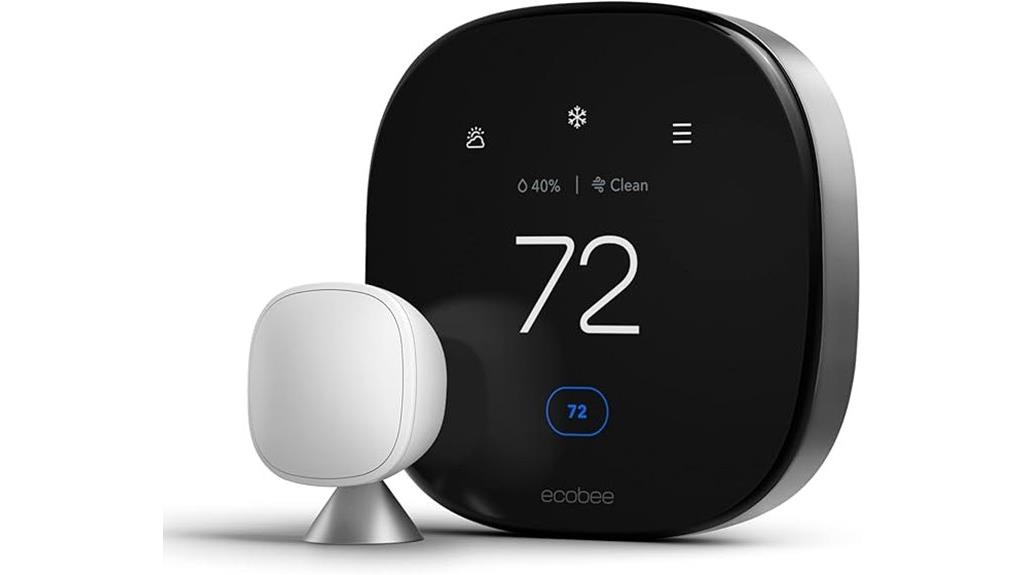
If you’re looking for a smart thermostat that prioritizes air quality and personalized comfort, the ecobee Smart Thermostat Premium is an excellent choice. It saves up to 26% annually on heating and cooling costs and is ENERGY STAR certified. The built-in air quality monitor alerts you to poor air, offers tips for improvement, and reminds you to change filters. Its SmartSensor detects open doors and windows, saving energy by pausing your HVAC. Plus, the sleek design features a vibrant display and advanced sensing to enhance your experience. With voice control options via Siri or Alexa, it’s both smart and user-friendly for allergy sufferers.
Best For: homeowners seeking an energy-efficient, air-quality-focused smart thermostat with advanced sensing and voice control capabilities.
Pros:
- Saves up to 26% annually on heating and cooling costs, reducing energy bills.
- Built-in air quality monitor and SmartSensor optimize comfort and environmental health.
- Compatible with most 24VAC HVAC systems and supports voice control via Siri or Alexa.
Cons:
- Requires an Apple Home Hub for Siri integration, adding extra setup.
- Security features such as alerts for break-ins require a paid ecobee Smart Security plan.
- Premium design and features may come at a higher price point compared to basic thermostats.
ecobee Smart Thermostat Enhanced, WiFi Programmable Thermostat

The ecobee Smart Thermostat Enhanced stands out for its ability to optimize comfort while saving energy, making it an excellent choice for allergy sufferers who want precise control over their indoor environment. It can save up to 26% annually on heating and cooling costs by automatically adjusting temperatures when you’re away and preheating or precooling your home before you arrive. It also monitors humidity and uses SmartSensor technology to focus on key areas, ensuring consistent comfort. With compatibility for most smart home platforms and easy remote control via the Ecobee app, it’s a reliable, energy-efficient solution to improve your indoor air quality and comfort.
Best For: allergy sufferers and homeowners seeking precise climate control, energy savings, and smart home integration for enhanced indoor comfort.
Pros:
- Automates temperature adjustments to optimize comfort and energy efficiency
- Monitors humidity and uses SmartSensor technology for focused room comfort
- Compatible with most smart home platforms and easy to control remotely via the Ecobee app
Cons:
- Requires Wi-Fi connection for full functionality, which may not be reliable in all areas
- Installation can be complex for some users without prior HVAC or smart device experience
- Cost may be higher compared to basic thermostats without smart features
Amazon Smart Thermostat
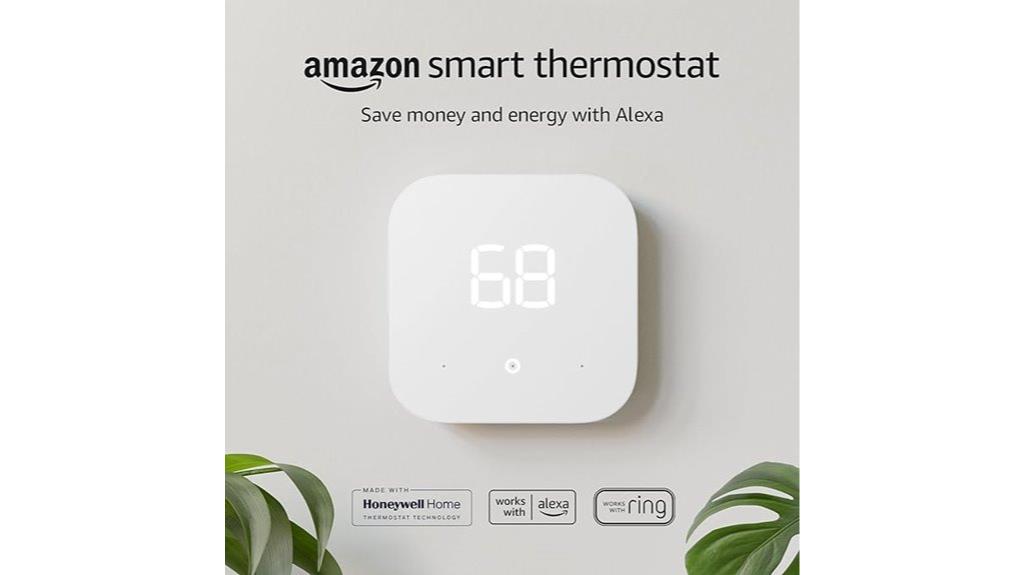
The Amazon Smart Thermostat stands out for its seamless integration with Alexa and Ring devices, making it an ideal choice for allergy sufferers who want hands-free control over their home environment. It supports C-wire installation, simplifying upgrade from traditional thermostats. With compatibility with Echo devices and the Amazon Smart Air Quality Monitor, it can detect temperature fluctuations and hot or cold spots. Alexa’s automation adjusts temperatures automatically based on your routines, and remote control via the app adds convenience. Backed by Honeywell technology, it’s reliable and durable. Plus, it helps save energy and costs, with potential rebates from local providers, making it both smart and budget-friendly.
Best For: allergy sufferers and smart home enthusiasts seeking seamless, voice-controlled temperature management and energy savings.
Pros:
- Supports C-wire installation for easy upgrade from traditional thermostats
- Seamless integration with Alexa, Ring, and Echo devices for voice control and automation
- Helps save on energy costs with potential rebates and ENERGY STAR certification
Cons:
- Requires compatible smart home devices for full functionality
- May involve initial setup steps that could be challenging for non-technical users
- Limited to homes with existing C-wire or compatible wiring infrastructure
Sensi Smart Thermostat
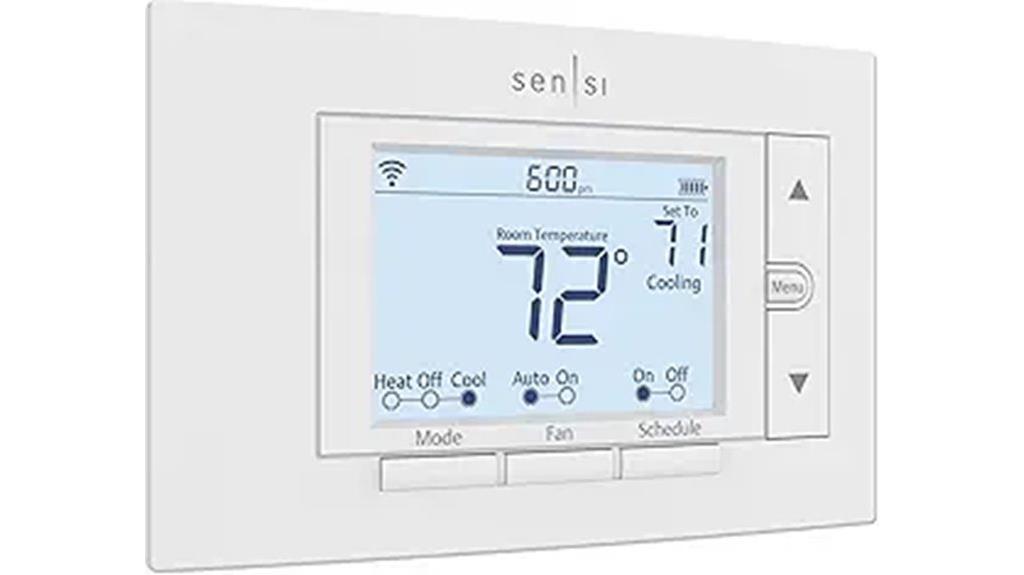
For allergy sufferers seeking precise climate control, the Sensi Smart Thermostat stands out with its humidity management features and reliable performance. It offers Wi-Fi connectivity, programmable scheduling, and voice control compatibility with Alexa, Google Assistant, and others. Its sleek LED display and easy DIY installation make setup simple, often without needing a common wire. With features like filter indicators, auto changeover, and humidity control, it helps maintain a healthier indoor environment. Certified by Energy Star, the Sensi Thermostat can cut HVAC energy bills by around 23%. Its dependable performance, user-friendly app, and smart maintenance alerts make it an excellent choice for allergy sufferers aiming to optimize home comfort.
Best For: allergy sufferers and homeowners seeking precise climate control, humidity management, and energy savings through easy DIY installation and reliable smart features.
Pros:
- Humidity management and filter indicators improve indoor air quality and comfort
- Easy DIY installation with clear app instructions and built-in level for straightforward setup
- Energy Star certification and programmable scheduling can reduce HVAC bills by approximately 23%
Cons:
- Limited detailed usage data and reporting features compared to higher-end models
- No support for Bixby voice control, which may be a drawback for some smart home users
- Occasional connectivity or setting adjustment issues reported by a few users
Sensi Lite Smart Thermostat

If you want a straightforward, easy-to-install thermostat that helps reduce energy use, the Sensi Lite Smart Thermostat is a solid choice. Made by Emerson, it’s Energy Star certified and compatible with most HVAC systems, including boilers, heat pumps, and air conditioners. It features an LCD display, backlight, and simple style, plus app control via Wi-Fi that works with Alexa, Google Assistant, and SmartThings. You can set programmable schedules, use auto changeover, and monitor filter status. Installation is quick with step-by-step instructions and minimal wiring required. While it’s most suitable for 24V systems, some wiring considerations apply for heat pumps.
Best For: homeowners seeking an easy-to-install, energy-saving smart thermostat compatible with a variety of HVAC systems.
Pros:
- Simple DIY installation with clear instructions and minimal wiring required
- Compatible with major smart home platforms like Alexa, Google Assistant, and SmartThings
- Energy Star certified, helping to reduce HVAC energy consumption
Cons:
- Wi-Fi connectivity issues reported after power outages or battery changes
- Limited scheduling flexibility and app features compared to higher-end models
- Not recommended for global use outside US/Canada and may require additional wiring considerations for heat pumps
meross Smart Thermostat for Home
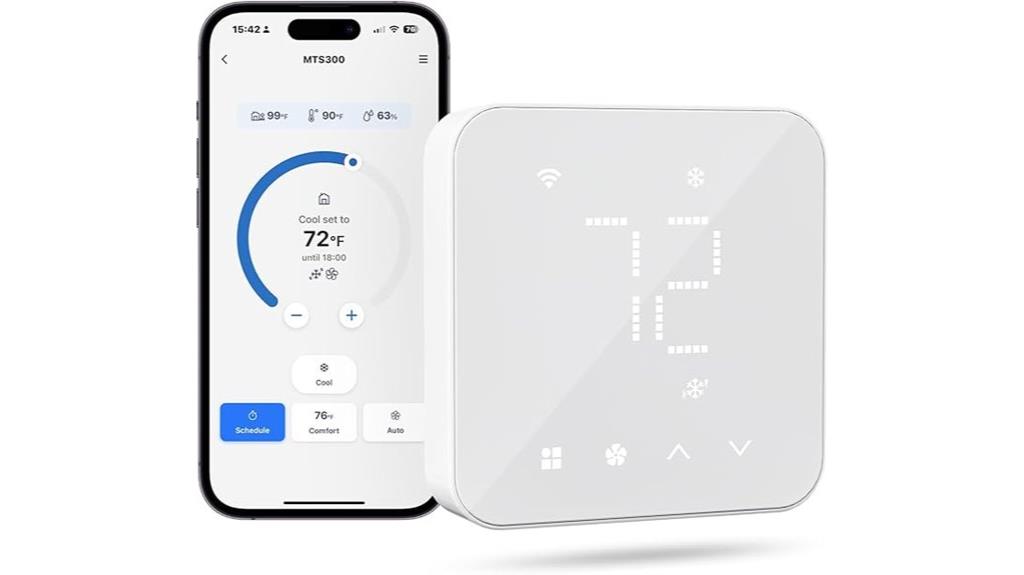
When you need a reliable smart thermostat compatible with most HVAC systems, the meross Smart Thermostat for Home stands out as a practical choice. It works with 95% of systems, including traditional heating, cooling, heat pumps, and combo setups, but not electric baseboard heaters. You’ll need a C-wire for installation, or you can use a Meross adapter if you don’t have one. It supports 2.4GHz Wi-Fi and offers customizable 7×24-hour scheduling, which works even without internet. With Matter support, it integrates seamlessly with Apple Home, Alexa, Google, and SmartThings, plus remote control via the app to optimize your home’s comfort and energy use.
Best For: homeowners seeking a versatile, easy-to-integrate smart thermostat compatible with most HVAC systems and supporting voice control.
Pros:
- Compatible with 95% of HVAC systems, including traditional and heat pump setups
- Supports customizable 7×24-hour scheduling that functions offline
- Seamless integration with Apple Home, Alexa, Google, and SmartThings via Matter technology
Cons:
- Not compatible with electric baseboard heaters
- Requires a C-wire for installation, which may necessitate an adapter
- Only supports 2.4GHz Wi-Fi networks, limiting connectivity options
Honeywell Wi-Fi Smart Color Thermostat
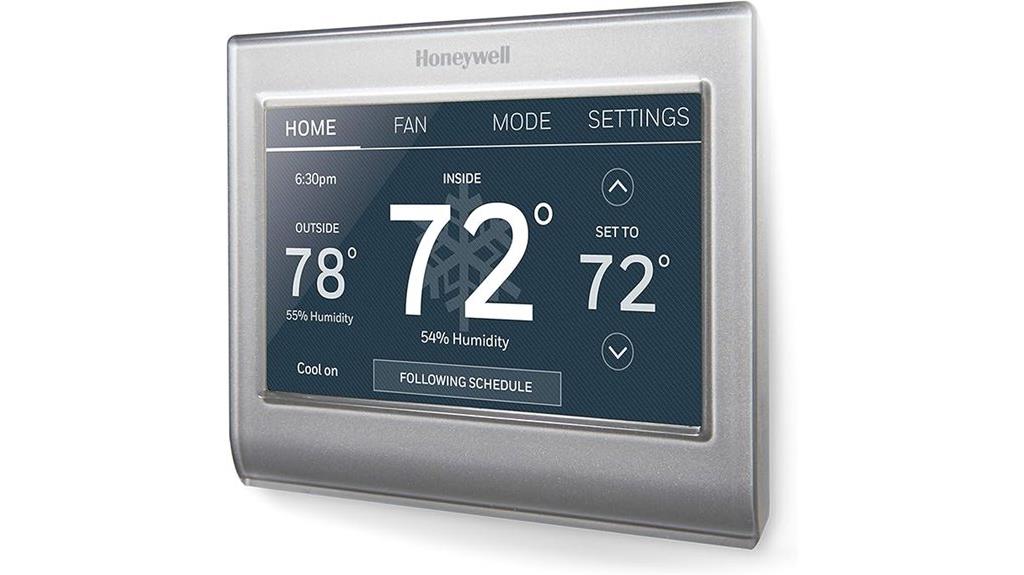
The Honeywell Wi-Fi Smart Color Thermostat stands out with its customizable full-color touchscreen and intuitive interface, making it an excellent choice for allergy sufferers who want precise climate control. It supports 7-day scheduling, displays indoor temperature, outdoor weather, and humidity, helping you maintain a comfortable environment. Compatible with Alexa, Google Home, and SmartThings, it’s easy to control remotely via Wi-Fi. Its sleek design and customizable colors enhance your home’s aesthetic. Installation is straightforward for DIYers, but you’ll need a C-wire. Overall, users praise its responsiveness, convenience, and detailed climate management—ideal for creating an allergy-friendly home environment.
Best For: those seeking a customizable, Wi-Fi-enabled smart thermostat with detailed climate control and aesthetic flexibility to enhance allergy-friendly home environments.
Pros:
- Intuitive full-color touchscreen with customizable display options
- Supports 7-day programmable scheduling and remote control via Wi-Fi
- Compatible with popular smart home platforms like Alexa, Google Home, and SmartThings
Cons:
- Requires a C-wire for installation, which may involve rewiring or adapting existing wires
- Limited fan control options (ON, AUTO, CIRCULATING)
- Some features and app functionalities may be region-specific or limited outside the US
Emerson Sensi Touch Wi-Fi Smart Thermostat
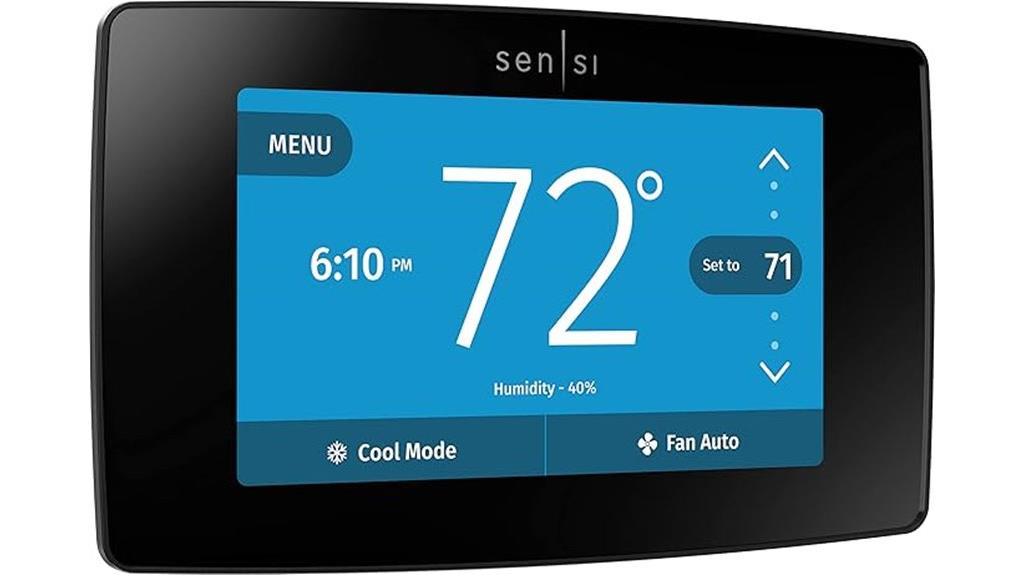
The Emerson Sensi Touch Wi-Fi Smart Thermostat stands out for allergy sufferers who want precise control over their indoor environment, thanks to its large 4.3-inch color touchscreen. Its sleek design, available in multiple colors, fits seamlessly into any home. It’s Energy Star certified, helping save about 23% on HVAC energy through flexible scheduling and remote control. The app integration supports Alexa, Google Assistant, Apple HomeKit, and SmartThings, allowing easy voice commands. Installation is straightforward with a common C-wire, and the device offers features like filter indicators and geofence technology. Overall, it’s a reliable, user-friendly thermostat that enhances comfort and energy efficiency.
Best For: homeowners seeking a stylish, easy-to-install smart thermostat with precise control and energy-saving features.
Pros:
- Large 4.3-inch color touchscreen for easy readability and control
- Supports multiple voice assistants including Alexa, Google Assistant, Apple HomeKit, and SmartThings
- Energy Star certified, helping save approximately 23% on HVAC energy costs
Cons:
- Requires a common C-wire for full functionality; no battery-only operation
- Registration and remote control features may be limited outside North America
- Basic compatibility with Apple HomeKit; some scheduling features may not work fully in certain regions
Honeywell Home Smart Thermostat, WiFi for Home

Looking for a smart thermostat that seamlessly integrates with your existing home system and helps maintain a healthy indoor environment? The Honeywell Home Smart Thermostat, WiFi for Home, is a versatile choice. It’s ENERGY STAR certified and compatible with conventional and heat pump systems. With WiFi connectivity and Matter certification, it works with Alexa, Google Assistant, and Apple HomeKit. Its customizable scheduling, geofencing, and humidity monitoring optimize comfort and energy efficiency. While setup is straightforward, some users encounter WiFi connectivity issues. Overall, it’s a reliable, user-friendly device that supports remote control and offers a sleek design, making it a solid option for allergy-conscious homes.
Best For: homeowners seeking a versatile, energy-efficient smart thermostat that integrates seamlessly with various smart home platforms and offers remote control capabilities.
Pros:
- ENERGY STAR certified, promoting energy savings and efficiency
- Compatible with Alexa, Google Assistant, and Apple HomeKit due to Matter certification
- Customizable scheduling, geofencing, and humidity monitoring for enhanced comfort
Cons:
- Some users experience WiFi connectivity issues and frequent offline status
- Basic control options within Apple HomeKit are limited to essential functions
- Setup and initial wiring can be vague or challenging without online support
Sensi Touch 2 Smart Thermostat with Touchscreen

If you’re seeking a user-friendly smart thermostat that combines intuitive controls with energy savings, the Sensi Touch 2 Smart Thermostat with Touchscreen is an excellent choice. Its vibrant color display makes programming easy, and Wi-Fi connectivity lets you control it remotely. Certified by ENERGY STAR, it can cut HVAC energy use by around 23%, helping lower your bills. It works seamlessly with Alexa and supports Sensi Room Sensors (sold separately) for balanced temperatures. Installation is straightforward with a common C-wire, and the Sensi app guides you through setup. Plus, it monitors your system, provides usage reports, and sends maintenance alerts to keep your home comfortable and efficient.
Best For: homeowners seeking an easy-to-use, energy-efficient smart thermostat with a vibrant touchscreen display and remote control capabilities.
Pros:
- User-friendly touchscreen color display for simple programming and adjustments
- ENERGY STAR certified, capable of reducing HVAC energy use by approximately 23%
- Seamless integration with Alexa and compatibility with Sensi Room Sensors for balanced temperature control
Cons:
- Requires a common C-wire for installation, which may not be available in all homes
- Sensi Room Sensors are sold separately, adding to the overall cost if you want temperature balancing throughout the home
- Limited to Wi-Fi connectivity, so internet outages can temporarily affect remote control features
Honeywell Home T9 WiFi Smart Thermostat
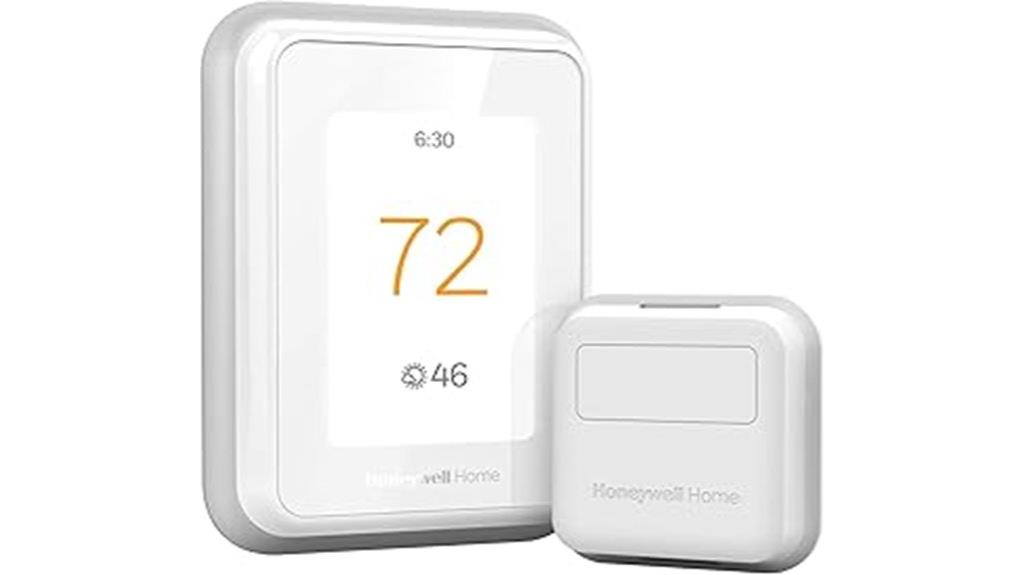
For allergy sufferers seeking precise climate control, the Honeywell Home T9 WiFi Smart Thermostat stands out thanks to its compatibility with smart room sensors. These sensors monitor temperature and humidity in multiple rooms, helping create a balanced, comfortable environment. The T9 supports various control options, including the Honeywell app, Alexa, Google Assistant, and Apple HomeKit, making it versatile and easy to use. It adjusts heating and cooling based on occupancy, schedules, or geofencing, which helps optimize energy use and indoor air quality. Although installation is straightforward, some users report Wi-Fi connectivity issues and challenges mounting sensors securely. Still, its multi-room control offers significant allergy-friendly benefits.
Best For: allergy sufferers and homeowners seeking precise, multi-room climate control with smart sensor integration and versatile control options.
Pros:
- Supports multiple control methods including app, Alexa, Google Assistant, and Apple HomeKit for convenience.
- Compatible with smart sensors to monitor and balance temperature and humidity across rooms.
- Designed for easy DIY installation with guided setup and energy-saving features.
Cons:
- Wi-Fi connectivity issues, especially with 5GHz networks, can affect performance.
- Sensors’ adhesive mounting may be unreliable, requiring additional securing methods.
- Higher price point over $300, which may be a consideration for budget-conscious users.
Honeywell WiFi Smart Thermostat (RTH8800WF2022)

The Honeywell WiFi Smart Thermostat (RTH8800WF2022) stands out as an excellent choice for allergy sufferers who want precise climate control combined with energy savings. Its 7-day programmable touchscreen and geofencing technology allow me to customize my home’s temperature effortlessly, ensuring comfort when I’m home and savings when I’m away. Supported by Energy Star certification, it helps reduce my energy bills by 8-16%, and I can access monthly reports with tips to optimize usage. Alexa compatibility adds voice control convenience. Just make sure I have a C-wire, especially for oil furnaces, to guarantee smooth operation and reliable connectivity.
Best For: allergy sufferers seeking precise, energy-efficient climate control with customizable scheduling and smart features.
Pros:
- Supports 7-day programmable touchscreen and geofencing technology for personalized comfort and energy savings
- ENERGY STAR certified, helping to reduce energy bills by 8-16% and providing monthly energy reports with tips
- Alexa compatibility allows for convenient voice control and easy integration into smart home systems
Cons:
- Requires a C-wire power adapter for proper operation, especially with oil furnaces
- Not compatible with heating-only oil systems unless a C-wire is present
- May involve additional setup or compatibility checks before purchase
Honeywell Home Wi-Fi 7-Day Programmable Thermostat, RTH6580WF
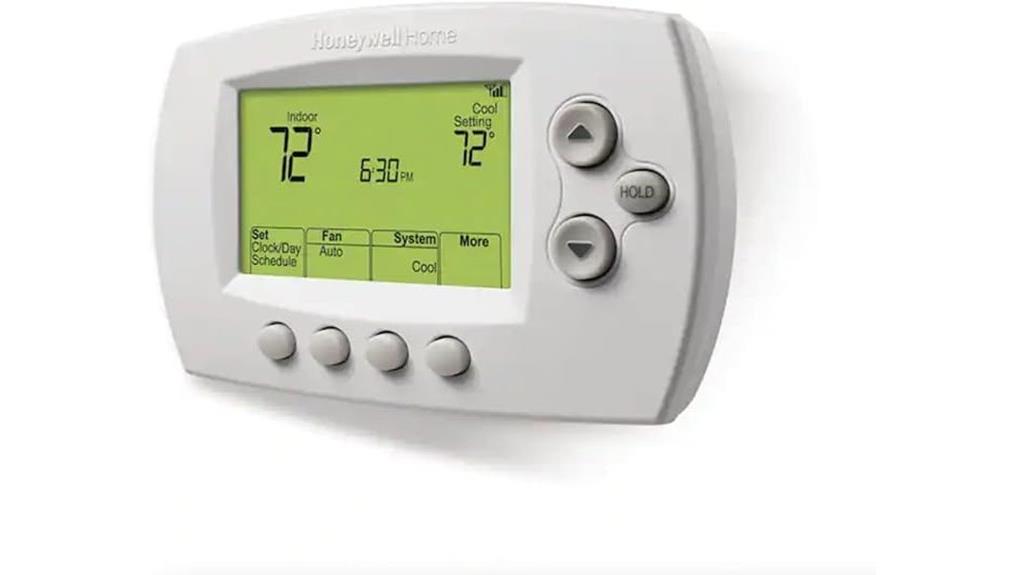
The Honeywell Home Wi-Fi 7-Day Programmable Thermostat, RTH6580WF, stands out as a budget-friendly option for those seeking remote control and customizable scheduling. It’s ENERGY STAR certified, helping you save energy with monthly reports and personalized tips. Compatible with Alexa, Google Assistant, and Cortana, it offers flexible 7-day, 4-period programming to fit your lifestyle. The large, backlit display makes adjustments easy, and app control via Total Connect Comfort or Resideo apps allows remote management. Installation requires a C-wire or an adapter, and setup involves wiring, mounting, and connecting to Wi-Fi. Overall, it’s a reliable, cost-effective choice for improving home comfort.
Best For: budget-conscious homeowners seeking remote control, flexible scheduling, and energy savings without premium features.
Pros:
- Affordable price point with reliable remote access and scheduling capabilities
- ENERGY STAR certified, promoting energy efficiency and cost savings
- Compatible with popular voice assistants like Alexa, Google Assistant, and Cortana
Cons:
- Requires a C-wire or an adapter for installation, which may complicate setup for some users
- Limited energy usage data and control features compared to higher-end models
- Dependence on cloud connectivity means functionality can be affected during internet outages
RTH7600D 7-Day Programmable Touchscreen Thermostat, White

With its large, backlit touchscreen display and intuitive programming options, the RTH7600D 7-Day Programmable Thermostat makes it easy to set and adjust your home’s temperature precisely, which is especially helpful for allergy sufferers who need consistent indoor conditions. It supports detailed weekly scheduling with four periods per day, allowing tailored control over heating and cooling. Compatible mainly with single-stage systems, heat pumps, and electric baseboards, it’s simple to install with minimal wiring. Its Smart Response Technology learns startup times for ideal comfort, while features like filter alerts and low battery indicators help maintain a healthy environment. Overall, it’s a reliable, budget-friendly choice for consistent indoor climate control.
Best For: homeowners seeking an easy-to-use, programmable thermostat compatible with single-stage heating and cooling systems for reliable indoor climate control.
Pros:
- Large, backlit touchscreen display for straightforward programming and adjustments
- Supports detailed weekly scheduling with four periods per day for customized comfort
- Features like Smart Response Technology and filter alerts enhance convenience and system efficiency
Cons:
- Limited compatibility mainly to single-stage systems, not suitable for multi-stage HVAC setups
- Programming setup can be less intuitive, requiring careful following of instructions
- Only powered by batteries, which may require periodic replacement
Factors to Consider When Choosing a Smart Thermostat for Allergy Sufferers
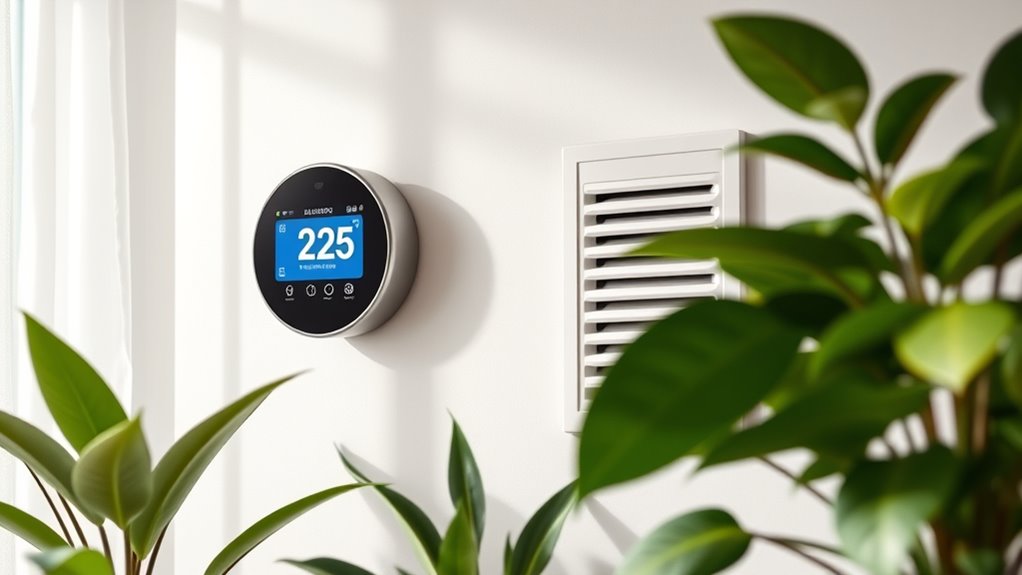
When selecting a smart thermostat for allergy relief, I consider features like air quality monitoring and compatibility with HEPA filters or air purifiers. It’s also important to look for precise temperature control and humidity regulation to reduce allergens effectively. These factors help create a healthier indoor environment and make allergy management easier.
Air Quality Monitoring Capabilities
Choosing a smart thermostat with robust air quality monitoring features can make a significant difference for allergy sufferers. These devices can detect pollutants, VOCs, and particulate matter, helping you understand your indoor air better. Many models alert you when air quality drops and offer tips for improving ventilation or using air purifiers, which is essential for reducing allergens. Built-in sensors track humidity, temperature, and air contaminants, giving you a complete view of your environment. Some thermostats also remind you to change or clean HVAC filters, preventing allergen buildup. Accurate air quality data empowers you to take proactive steps, like increasing airflow or activating purification systems, to minimize allergy symptoms and maintain a healthier home environment.
HEPA and Air Purifier Integration
Integrating HEPA filters and air purifiers with smart thermostats can greatly enhance indoor air quality for allergy sufferers. HEPA-enabled systems capture 99.97% of airborne particles as small as 0.3 microns, including dust, pet dander, and pollen, reducing allergens effectively. Smart thermostats that connect with air purifiers allow for automated activation during high pollen or pollution periods, ensuring cleaner air when you need it most. Some models even link directly with air quality monitors, enabling real-time adjustments based on indoor pollutant levels. Additionally, using thermostats with built-in air quality sensors helps maintain ideal humidity and airflow, preventing mold and dust mite growth. Coordinating these systems ensures continuous allergen filtration, especially during peak allergy seasons or high outdoor pollution days.
Filtration System Notifications
Filtration system notifications are essential features to contemplate because they keep you informed about your air quality and filter status in real time. These alerts can warn you when indoor air quality drops or when filters need replacing, helping you act before allergens build up. Some thermostats even notify you about furnace or air purifier filter changes, ensuring your filtration remains effective. Real-time alerts for sudden temperature drops can also signal system issues that impact air cleanliness. Integration with smart sensors allows specific room notifications, so you know exactly where attention is needed. Regular maintenance reminders from the thermostat help keep your filtration system functioning *perceptively*, reducing airborne allergens and irritants. Overall, these notifications enable proactive management of your home’s air quality, essential for allergy sufferers.
Precise Temperature Control
Accurate temperature control is essential for creating a comfortable and healthy environment, especially for allergy sufferers. Precise control minimizes hot and cold spots, ensuring consistent comfort throughout your home. Thermostats with room-specific sensors can adjust temperatures based on individual room conditions, preventing temperature fluctuations that can stir up allergens. Maintaining stable indoor temperatures also reduces the circulation of airborne allergens triggered by sudden changes. Fine-tuning temperature settings helps optimize air filtration and humidity levels, which are critical for reducing mold and dust mites. By choosing a thermostat that offers precise regulation, you support better air quality and minimize allergen growth. Overall, accurate temperature control is a fundamental factor in creating a safer, more comfortable living space for allergy sufferers.
Humidity Regulation Features
Maintaining proper humidity levels is essential for allergy sufferers, and many smart thermostats now offer features that make this easier. These devices can help keep indoor moisture between 30-50%, which is ideal for reducing allergy triggers like mold and dust mites. Some thermostats come with built-in humidifiers or dehumidifiers that automatically adjust humidity based on sensor data, ensuring consistent comfort. Monitoring humidity levels allows me to prevent environments that are too dry or damp, both of which can worsen respiratory issues. By maintaining balanced humidity, these thermostats not only improve air quality but also create a healthier, more comfortable home environment. This feature is especially important for allergy sufferers looking to minimize symptoms and breathe easier year-round.
Smart Sensor Placement
Choosing the right placement for your smart sensors can considerably improve your home’s air quality management, especially for allergy sufferers. Proper placement ensures accurate detection of air quality and temperature, which is crucial for effective regulation. I recommend positioning sensors away from windows, vents, and sources of dust or pollutants to prevent skewed readings. Mounting sensors at ear level or in central locations helps capture representative air conditions, making the thermostat’s adjustments more precise. Placing sensors in frequently used areas enhances the effectiveness of alerts and automated responses to allergens. Additionally, regularly repositioning or calibrating sensors keeps measurements accurate, allowing you to maintain a healthier indoor environment. Thoughtful sensor placement can make a significant difference in managing allergens and improving overall comfort.
Compatibility With Air Purifiers
To effectively reduce allergens and improve indoor air quality, choosing a smart thermostat that can seamlessly integrate with air purifiers is vital. Look for models compatible with popular smart home platforms or dedicated apps to guarantee smooth synchronization. Ideally, the thermostat should automatically adjust HVAC settings based on real-time air quality sensor data, optimizing indoor conditions. It’s also helpful if it allows custom automation rules that turn on or boost air purifier activity when pollutants or allergens are detected. Devices with open APIs or compatibility with third-party ecosystems make integration easier, providing more control and flexibility. Additionally, some thermostats monitor indoor air quality directly and can trigger alerts or adjustments, helping maintain a healthier environment for allergy sufferers.
Allergy-Friendly Scheduling
Since indoor allergens can vary throughout the day, scheduling features in a smart thermostat let you tailor air quality management to your specific needs. You can set specific times for air quality monitoring and ventilation adjustments, reducing allergens when allergy symptoms are most severe. Programmable thermostats help maintain ideal humidity levels, preventing mold and dust mites from thriving. Scheduling air filtration or purification during peak allergy hours minimizes exposure to pollen, pet dander, and airborne allergens. Consistent temperature regulation through scheduling reduces fluctuations that can stir up dust and other irritants. Additionally, automated reminders for filter changes and air quality checks ensure your system stays effective. These scheduling options give you better control over your indoor environment, making allergy management more efficient and effective.
Frequently Asked Questions
How Do Smart Thermostats Help Reduce Allergens in the Air?
When I ask how smart thermostats help reduce allergens, I realize they do more than just control temperature. They can learn my schedule, optimize humidity levels, and even sync with air purifiers. By maintaining consistent, ideal conditions, they help prevent mold growth and dust mites. I’ve found that these features create a healthier home environment, making allergy symptoms less severe and breathing easier for me.
Can Smart Thermostats Automatically Detect Allergy Symptoms?
Smart thermostats can’t directly detect allergy symptoms, but they can monitor air quality and humidity levels, which helps reduce allergens. Some models connect to air purifiers or humidifiers and adjust them automatically to maintain ideal conditions. While they don’t diagnose symptoms, they create a healthier environment by controlling factors that trigger allergies, making your home more comfortable and less allergenic.
Are There Specific Features for Allergy Sufferers in Smart Thermostats?
Imagine waking up with allergy symptoms, and your thermostat adjusts the air quality instantly. Some smart thermostats have features like air purifying control or humidity regulation, which help reduce allergens. For example, a thermostat might automatically lower humidity levels to prevent mold growth. These features are designed specifically for allergy sufferers, creating a healthier and more comfortable home environment by managing air quality and reducing triggers.
How Do Smart Thermostats Improve Air Quality Monitoring Accuracy?
Smart thermostats improve air quality monitoring accuracy by using advanced sensors that detect temperature, humidity, and sometimes air pollutants more precisely. I’ve noticed they constantly update data, allowing me to adjust settings in real-time. This helps me maintain a healthier environment, especially for allergy relief. With their enhanced sensors and intelligent algorithms, I can trust these devices to give me a clear picture of my home’s air quality, making it easier to create a comfortable space.
Can Smart Thermostats Integrate With Air Purifiers or Allergen Filters?
Imagine walking into a room where the air feels just right—that’s what smart thermostats can do by integrating with air purifiers or allergen filters. I’ve seen how seamless this connection is, allowing me to automate air quality improvements effortlessly. When the thermostat detects increased allergens, it can trigger filters to run, creating a healthier environment without me lifting a finger. It’s like having a personal air quality assistant in your home.
Conclusion
Did you know that HVAC systems can circulate allergens, worsening allergy symptoms? Choosing the right smart thermostat can help improve your home’s air quality and comfort. With options like the ecobee Smart Thermostat Premium or Honeywell models, you can optimize temperature and airflow to reduce allergens effectively. Investing in a smart thermostat isn’t just about convenience — it’s a smart move for your health, especially if allergies are a daily challenge.
